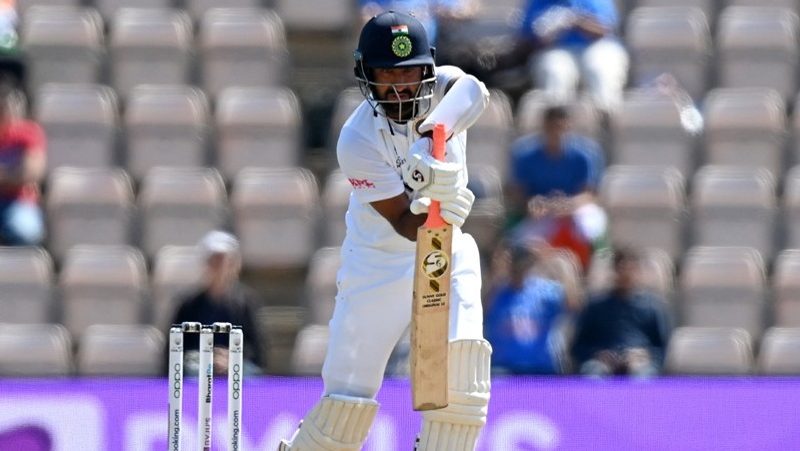
For about an hour at Lord’s in 2018, it looked as if the Indian cricket team would finally be able to form a partnership without Virat Kohli’s presence in the middle. It was their fourth innings of the five-Test series against England, and Cheteshwar Pujara was fighting the good old fight, alongside Ajinkya Rahane.
As always, he was doing it his way: watching the ball ever so closely, pulling his bat away from deliveries in the channel, making no attempt to go for wider ones, and squeezing out the odd run when the rare ball arrived on the pads.
Pujara stood firm for 17 off 87 balls, easily the most faced by an Indian batsman in the entire match. Then Stuart Broad came up with the big, surprise inswinger, and even Pujara could not keep it from rattling the stumps.
The Pujara method
The third-wicket stand had resisted for almost 13 overs, but had added only 22 runs. Not for the first time, Pujara’s method had come unstuck in difficult batting conditions and India had gone nowhere despite playing out some time.
It is an approach that has brought him 6,267 runs in 86 Tests at an average of 46.08. That is overwhelming proof that it works, and has been working for years now.
He averages 56.31 in India and 47.28 in Australia, places where playing out time – the Pujara method – tires out the bowlers and blunts the new ball, making it progressively easier for him and the more aggressive batsmen following him. India’s twin Test-series wins in Australia owe their weight in gold to Pujara.
Little return in England
But bowlers do not tire as much in England’s cooler weather. And the Dukes ball used there keeps moving around even in the 60th over. You may have faced 150 deliveries with a defensive mindset but the 151st could still be unplayable.
An approach that stresses primarily on spending time at the crease is thus high risk for little return in typical English conditions. Pujara faced 134 balls for only 23 runs in the World Test Championship (WTC) final. New Zealand’s four specialist fast bowlers kept charging in, and India’s scoreboard remained stuck.
Pujara’s balls per dismissal in England – 72.1 – falls considerably compared to his overall career number -- 103.22. Tellingly, among the 66 visiting batsmen to have faced at least 1370 Test deliveries in England – the same number as Pujara has – his 523 runs (average 27.52) are the fewest.
More ‘intent’
There has been a lot of pressure over the years from the Indian team management on Pujara to show more ‘intent.’ It has also resulted in ridiculous outcomes such as him taking needless risk and being run out twice in the same Test, at Centurion against South Africa in 2018.
Into his 34th year, there is next to no chance of Pujara altering his approach. And for good reason too; it has brought him 6000-plus Test runs. But it largely hasn’t worked in England; his only century there came in almost Indian conditions in 2018 in Southampton, where even Moeen Ali’s part-time off-spin claimed nine wickets. His two fifties in England came in a high-scoring draw in Nottingham 2014 and after India were sitting pretty on an overall lead of 228 in Nottingham 2018.
‘Take more risks’
After the WTC final defeat, Kohli said that he wanted his batsmen to take more risks. “The mindset has to be to score runs and find ways to score runs,” Kohli said. “You can't be too worried about getting out because you are bringing the bowler into the game completely and not moving the game forward…
"The idea from here on will be to try to score runs and not worry about getting out in testing conditions… otherwise you're just literally standing there hoping that you don't get out and eventually you will because you're not being optimistic enough.”
Bring Rahul or Agarwal in?
If Kohli wants someone to drive the innings forward at No. 3 in England, Pujara is not going to be that man.
Without any disrespect meant to Pujara’s overall record, India should consider playing one of their brisker reserve openers – Mayank Agarwal and KL Rahul – in his place, at least for the first two or three Tests against England in August.
They had played Rahul at No. 3 instead of Pujara for the series opener in Birmingham in 2018 but brought the Saurashtra batsman back for the remaining four Tests.
An alternative could be that Agarwal opens along with Rohit Sharma and Shubman Gill drops to No. 3, a position some think he could be more suited to.
Pujara is already going to be remembered as one of the finest of Indian cricket, and being dropped for the specific conditions of England in a few Tests is not going to change that.
Author: Abhishek Purohit
Featured Photo: AFP / Glyn Kirk




















